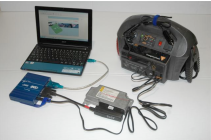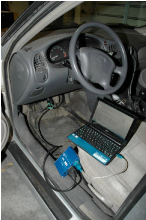Electronic Data – black boxes
Heavy Trucks and Buses
Heavy trucks may record data in their Engine Control Module (ECM) and/or other modules within the truck. This data is typically engine dependent (e.g. Cummins, Detroit Diesel, Paccar, etc.), not manufacturer specific. The data is not crash dependent, but typically is recorded during a “Quick Stop” or “Sudden Deceleration” event, possibly triggered when a driver brakes hard before a crash. Downloading these heavy truck modules is often more involved than downloading passenger vehicles. Contact our office to discuss the possibility of extracting data from a particular heavy vehicle.
Infotainment Data (i.e. Berla iVe)
As vehicles become technically more complex, many vehicles store other data in various vehicle modules, like the infotainment system. We have the Berla iVeTM system, which a forensics extraction system to obtain this other data from various electronic vehicle modules. This data can include data transferred from cell phones via a BluetoothTM system, including text messages, geotracking data, etc. This data can be useful in fraud cases, as well as criminal cases. Extracting this data can be a time intensive process depending on the specific vehicle model.
Crash Data
Our offices can download electronic data from most newer vehicles. Most passenger vehicles are downloadable using the Crash Data RetrievalTM (CDR) system manufactured by Bosch. A few manufacturers have their own proprietary tools for downloading, such as Hyundai and Kia, and we have the equipment to download these Hyundai and Kia vehicles. Contact our office to inquire about the potential data available in a specific vehicle.
We can download crash data from the following brands:
- Audi (2015 and newer)
- BMW, Mini, Smart (2013 and newer)
- Chevrolet, GMC, Buick, Cadillac, Pontiac, Oldsmobile, Saturn (1994 and newer)
- Chrysler, Dodge, Ram, Jeep, Fiat, Plymouth (2005 and newer)
- Ford, Mercury, Lincoln (2001 and newer)
- Honda, Acura (2012 and newer)

- Hyundai (2013 and newer)
- Kia (2013 and newer)
- Mazda (2011 and newer)
- Mercedes-Benz (2014 and newer)
- Mitsubishi (2011 and newer)
- Nissan, Infiniti (2012 and newer)
- Porsche (2019 and newer)
- Rolls-Royce (2013 and newer)
- Subaru (2012 and newer)
- Suzuki (1995 and newer)
- Tesla
- Toyota, Lexus, Scion (2002 and newer)
- Volkswagen (2009 and newer, with some exceptions)
- Volvo (2011 and newer)
The above list is simply a general guideline. Some older models may be downloadable by removing the Air Bag Control Module (ACM) and sending it to the manufacturer for downloading. The specific year, make and model needs to be checked to verify if data is available. Check here for currently downloadable vehicles with the CDR system – https://www.crashdatagroup.com.
It should be noted that vehicle Event Data Recorders (EDR’s) are normally part of the air bag system. The primary purpose of an Air Bag Control Module (ACM) is to deploy the air bags, seat belt pre-tensioners and other safety equipment. After that task has been completed, data is written to the EDR if sufficient power remains in the system. This is the primary difference between an EDR in a vehicle and a black box in an airplane: the black box in an airplane is intended to continuously record information, whereas the EDR in a vehicle records data only if a sufficiently aggressive event occurs.
Data varies depending on the manufacturer, vehicle and model year of the vehicle. This data has changed over the past 20+ years. Some 1994 model year General Motors vehicles were downloadable, but the data was largely limited to driver’s seat belt status and impact severity (delta-V). However, in model year 2000, pre-crash data was available in General Motors vehicles for approximately 5 seconds leading up to the collision.  This pre-crash data included:
This pre-crash data included:
- wheel speed
- braking (on/off)
- accelerator pedal percent
- engine RPM
Since 2000, many manufacturers provide the above data and more, including:
- driver and front passenger seat belt status
- steering wheel angle
- cruise control status
- longitudinal and lateral delta-V
The EDR may record data even if the air bags or other safety equipment did not deploy. For example, in a low-speed collision or in a pedestrian collision, the EDR may record data (e.g. vehicle speed and delta-V) if the impact severity was sufficient. Typically, the only way to know if data was recorded is to download the EDR.
Newer vehicles are recording more and more data. Vehicles are starting to record data not only as part of the air bag system, but as part of other vehicle systems. Manufacturers are interested in the driving history of the vehicle and data may be stored in other electronic modules within the vehicle (e.g. Body Control Module or BCM). For example, some Toyota vehicles record data not retrievable by the CDR system, but only retrievable through Toyota diagnostic equipment (i.e. Toyota TechstreamTM or GTS+TM). This Toyota data can remain stored in the vehicle indefinitely, as part of the Vehicle Control History (VCH). The newest Toyota vehicles can even record images shortly before the collision. We have the equipment to access this VCH data. Other manufacturers are also starting to record images in additional to traditional EDR data.











